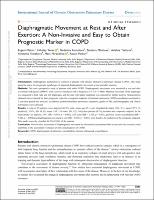| dc.contributor | Vall d'Hebron Barcelona Hospital Campus |
| dc.contributor.author | Mekov, Evgeni |
| dc.contributor.author | Yanev, Nikolay |
| dc.contributor.author | Kurtelova, Nedelina |
| dc.contributor.author | Mihalova, Teodora |
| dc.contributor.author | Tsakova, Adelina |
| dc.contributor.author | Yamakova, Yordanka |
| dc.contributor.author | Miravitlles Fernández, Marc |
| dc.contributor.author | Petkov, Rosen |
| dc.date.accessioned | 2022-09-07T11:35:06Z |
| dc.date.available | 2022-09-07T11:35:06Z |
| dc.date.issued | 2022-05-05 |
| dc.identifier.citation | Mekov E, Yanev N, Kurtelova N, Mihalova T, Tsakova A, Yamakova Y, et al. Diaphragmatic Movement at Rest and After Exertion: A Non-Invasive and Easy to Obtain Prognostic Marker in COPD. Int J Chron Obstruct Pulmon Dis. 2022 May 5;17:1041–50. |
| dc.identifier.issn | 1178-2005 |
| dc.identifier.uri | https://hdl.handle.net/11351/8047 |
| dc.description | COPD; Diaphragmatic dysfunction; Thoracic ultrasound |
| dc.description.abstract | Introduction: Diaphragmatic dysfunction is common in patients with chronic obstructive pulmonary disease (COPD). This study aimed to assess the prognostic significance of impaired diaphragmatic movement at rest and after exercise.
Methods: This was a prospective study of patients with stable COPD. Diaphragmatic movements were examined at rest and after a 6-minute walking test (6MWT) with a convex transducer with a frequency of 3.5-5-7.5 MHz. Maximal movement of the diaphragm was measured in both right and left diaphragm, and the side with higher amplitude was selected for further analysis. Measurements obtained were evaluated for their prognostic value for a composite endpoint of moderate and severe COPD exacerbations and death in 1 year time period was assessed. In addition, postbronchodilator spirometry, symptoms, quality of life, and demographic and clinical information were collected.
Results: A total of 96 patients were analyzed (62.5% male, mean age 65.1 years (standard deviation (SD): 8.1), mean FEV1 (% predicted): 55.8%, SD: 18.3%, mean CAT: 15.6 units, SD: 9.2). Sixty-four patients (67%) presented the composite endpoint. In the multivariate Cox analysis, FVC (HR = 0.944, p = 0.005), CAT score (HR = 1.133, p = 0.011), previous severe exacerbations (HR = 5.446, p = 0.004) and diaphragmatic movement at rest (HR = 0.932, p = 0.033) were found to be predictors of the composite endpoint. This model correctly classified 86.5% (83/96) of the patients.
Conclusion: Non-invasive assessment of diaphragmatic movement by ultrasound measurement both at rest and after exercise could contribute to the assessment of disease severity and prognosis of COPD. |
| dc.language.iso | eng |
| dc.publisher | Dove Medical Press |
| dc.relation.ispartofseries | International Journal of Chronic Obstructive Pulmonary Disease;17 |
| dc.rights | Attribution-NonCommercial 4.0 International |
| dc.rights.uri | http://creativecommons.org/licenses/by-nc/4.0/ |
| dc.source | Scientia |
| dc.subject | Pulmons - Malalties obstructives - Prognosi |
| dc.subject | Diafragma (Anatomia) |
| dc.subject | Exercici |
| dc.subject.mesh | Pulmonary Disease, Chronic Obstructive |
| dc.subject.mesh | /diagnosis |
| dc.subject.mesh | Physical Exertion |
| dc.subject.mesh | Prognosis |
| dc.title | Diaphragmatic Movement at Rest and After Exertion: A Non-Invasive and Easy to Obtain Prognostic Marker in COPD |
| dc.type | info:eu-repo/semantics/article |
| dc.identifier.doi | 10.2147/COPD.S361235 |
| dc.subject.decs | enfermedad pulmonar obstructiva crónica |
| dc.subject.decs | /diagnóstico |
| dc.subject.decs | esfuerzo físico |
| dc.subject.decs | pronóstico |
| dc.relation.publishversion | https://doi.org/10.2147/COPD.S361235 |
| dc.type.version | info:eu-repo/semantics/publishedVersion |
| dc.audience | Professionals |
| dc.contributor.organismes | Institut Català de la Salut |
| dc.contributor.authoraffiliation | [Mekov E] Department of Occupational Diseases, Medical University Sofia, Sofia, Bulgaria. [Yanev N, Kurtelova N, Mihalova T, Petkov R] Department of Pulmonary Diseases, Medical University Sofia, Sofia, Bulgaria. [Tsakova A] Central Clinical Laboratory, Medical University Sofia, Sofia, Bulgaria. [Yamakova Y] Department of Anesthesiology and Intensive Care, Medical University Sofia, Sofia, Bulgaria. [Miravitlles M] Servei de Pneumologia, Vall d’Hebron Hospital Universitari, Barcelona, Spain. Vall d’Hebron Institut de Recerca (VHIR), Barcelona, Spain. CIBER de Enfermedades Respiratorias (CIBERES), Barcelona, Spain |
| dc.identifier.pmid | 35547783 |
| dc.identifier.wos | 000797512200010 |
| dc.rights.accessrights | info:eu-repo/semantics/openAccess |

